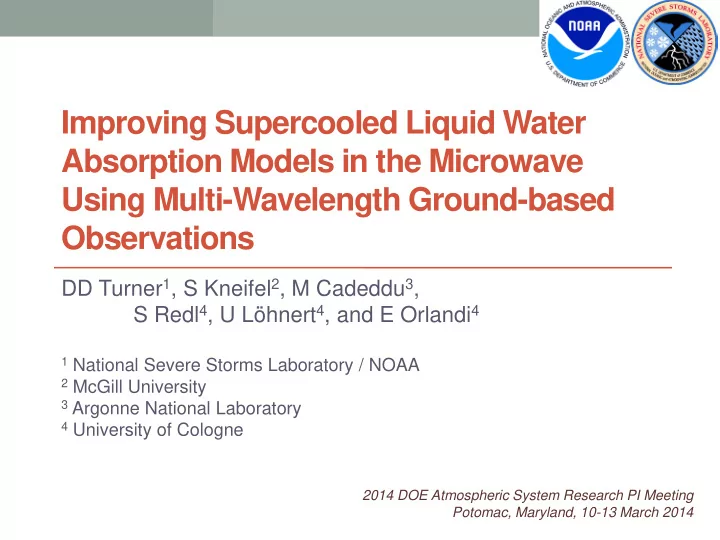

Improving Supercooled µwave Absorption Models DD Turner, 2014 ASR PI Meeting, Potomac, MD Improving Supercooled Liquid Water Absorption Models in the Microwave Using Multi-Wavelength Ground-based Observations DD Turner 1 , S Kneifel 2 , M Cadeddu 3 , S Redl 4 , U Löhnert 4 , and E Orlandi 4 1 National Severe Storms Laboratory / NOAA 2 McGill University 3 Argonne National Laboratory 4 University of Cologne 2014 DOE Atmospheric System Research PI Meeting Potomac, Maryland, 10-13 March 2014
Improving Supercooled µwave Absorption Models DD Turner, 2014 ASR PI Meeting, Potomac, MD Motivation • Accurate quantification of liquid water path (LWP) in clouds critical for many atmospheric studies • Microwave radiometers are the basic observational tools used to measure LWP • A large fraction of liquid-bearing clouds are supercooled (i.e., T cloud < 0°C) • There are very few laboratory observations of water vapor absorption coefficient in microwave at supercooled temps • Consequentially, microwave absorption models use semi- empirical models that are fit to warm lab data and extrapolate to supercooled temps • Translation: a lot of uncertainty in LWP for T cloud < 0°C !!
Improving Supercooled µwave Absorption Models DD Turner, 2014 ASR PI Meeting, Potomac, MD Absorption differences between models • MEI: Meissner and Wentz (2004) • RAY: Ray (1972) • LIE: Liebe et al. (1991, 1993) • STO: Stogryn et al. (1995) • ELL06: Ellison (2006) • ELL07: Ellison (2007)
Improving Supercooled µwave Absorption Models DD Turner, 2014 ASR PI Meeting, Potomac, MD Impact on retrieved LWP
Improving Supercooled µwave Absorption Models DD Turner, 2014 ASR PI Meeting, Potomac, MD Datasets used • AMF Black Forest Deployment • 31, 52, 90, 150 GHz; 500 m MSL • Zugspitze, Germany • 31, 52, 90, 150 GHz; 2650 m MSL • Summit Station, Greenland • 31, 52, 90, 150, 225 GHz; 3200 m MSL MWRs at Summit
Improving Supercooled µwave Absorption Models DD Turner, 2014 ASR PI Meeting, Potomac, MD Opacity ratios are the key • The total opacity is derived from MWR T b obs as • The total opacity is • Mätzler et al. (2010) presented a method to separate from and using the temporal variability of the liquid • Assuming cloud temp is fixed for a given cloud, then • Thus, the ratio of the fast opacity changes btwn two freqs is
Improving Supercooled µwave Absorption Models DD Turner, 2014 ASR PI Meeting, Potomac, MD Opacity changes example from Summit
Improving Supercooled µwave Absorption Models DD Turner, 2014 ASR PI Meeting, Potomac, MD Opacity ratios: Models vs. Obs
Improving Supercooled µwave Absorption Models DD Turner, 2014 ASR PI Meeting, Potomac, MD Absorption coefficient: Models vs. Obs
Improving Supercooled µwave Absorption Models DD Turner, 2014 ASR PI Meeting, Potomac, MD Building a new model • Previous models built using laboratory measurements to constrain semi-empirical models • Lab observations typically at temps between 0 and 100°C • 70% of lab measurements between 0 and 30°C • Observations span frequencies from 0.5 to 900 GHz • 87% of lab measurements are at frequencies below 60 GHz • Most models assume a “double Debye” form (9 parameters) • Ellison (2007) packaged the lab data into an easy-to-use format • Added our opacity ratio obs at supercooled temps to dataset • Used absorption by Stogryn model at 90 GHz to translate these opacity ratios into absorption coeffs at 31, 52, 150, and 225 GHz • Supported by Cadeddu and Turner (2011), Mätzler et al. 2010 • Used optimal estimation to fit new parameters for a double- Debye model • Uncertainty estimates and information content provided as result
Improving Supercooled µwave Absorption Models DD Turner, 2014 ASR PI Meeting, Potomac, MD Fitting the new model
Improving Supercooled µwave Absorption Models DD Turner, 2014 ASR PI Meeting, Potomac, MD Evaluating the new model: Lab data (1)
Improving Supercooled µwave Absorption Models DD Turner, 2014 ASR PI Meeting, Potomac, MD Evaluating the new model: Lab data (2)
Improving Supercooled µwave Absorption Models DD Turner, 2014 ASR PI Meeting, Potomac, MD Evaluating the new model: Lab data (3)
Improving Supercooled µwave Absorption Models DD Turner, 2014 ASR PI Meeting, Potomac, MD Evaluating the new model: Lab data (4)
Improving Supercooled µwave Absorption Models DD Turner, 2014 ASR PI Meeting, Potomac, MD Evaluating the new model: Field data
Improving Supercooled µwave Absorption Models DD Turner, 2014 ASR PI Meeting, Potomac, MD Conclusions • Multi-freq MWR obs at 3 diff locations demonstrate that: • Current liquid water model used by ARM (Liebe) isn’t very accurate, especially for higher frequencies • Stogryn model seems the best for freqs < 100 GHz • Ellison 2007 model seems the best for freqs > 100 GHz • No current model properly captures the temp and freq dependence • A new absorption model was created using lab and field data • Used optimal estimation framework; thus have uncertainties and DFS • Had to assume Stogryn model at 90 GHz was accurate to convert the opacity ratios from field data into absorption coefficients • New model fits both lab and field data well over from -32 < T cloud < 100 °C and 0.5 < freq < 500 GHz • Kneifel et al., JAMC 2014, in press • Discusses opacity ratio technique and evaluation of current models • Turner et al., in preparation • Describes the new LW microwave absorption model
Recommend
More recommend